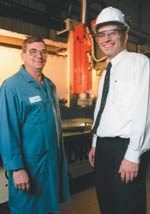A Better Process For Hole Making
This company is in the business of drilling millions of holes in very large parts. As an established manufacturer of heat exchangers and components, the Calgary, Alberta-based company drills an estimated 1.5 million holes per year in metal plates.
Share




Hwacheon Machinery America, Inc.
Featured Content
View More




Exchanger Industries is in the business of drilling millions of holes in very large parts. As an established manufacturer of heat exchangers and components, the Calgary, Alberta-based company drills an estimated 1.5 million holes per year in metal plates. These tube sheets–which vary in thickness from ¾ of an inch to 8 inches–are the main components used to isolate essential fluids in heat transfer equipment. The tube sheets perform a crucial role in the heating and cooling process streams for facilities such as gas plants, pumping stations and refineries.
In business since 1961, Exchanger started as a small shop with one radial arm drill and three employees. It has evolved into a company with 250 employees.
By 1990, the company already had six radial drills, four vertical boring mills, and a horizontal milling center on its shop floor. However, according to company President Blair Wetmore, the purchase of new CNC drilling equipment was the first step the company had to make in order to introduce more productive hole-making methods in-house. The company’s projected long-term cost savings justified the move to a CNC drilling process. “It’s the age-old equation of making money,” says Mr. Wetmore. “Lower cost, less time and increased production all lead to increased profit.”
Prior to 1990, Exchanger’s drilling was performed manually. According to Garry Auvigne, Exchanger’s machine shop supervisor, the process took approximately 110 hours to complete. The time involved to conduct this manual hole-making process led Exchanger Industries to examine other production alternatives. In July 1990, the company purchased a 60-inch by 60-inch by 12-inch CNC Compustep drill by Quickmill Inc., Peterborough, Ontario. Because of the machine’s performance, Exchanger later purchased two other, highly evolved CNC Quickdrill machines designed and built by Quickmill Inc.
In 1990, when Exchanger used its first Quickmill CNC drilling center to replace the radial arm drilling process on large sheets of plate, the process took 80 hours to complete. Today, on the company’s new Quickdrill 96, the same tube sheet takes only 16 hours to drill with Iscar 5/8 inch tooling. Work on the Quickdrill 96 is performed in one seamless process. In comparison to the company’s former radial drilling process, this represents a productivity gain of 94 hours per workpiece.
At Exchanger Industries, large parts are now drilled on the company’s Quickdrill 96. The other two machines are used for stack drilling header plates (four at a time with a 1-inch drill), making baffles, as well as making TEMA flanges and bolt holes in the periphery of the tube sheets.
According to John Michelin, engineering manager at Exchanger Industries, the benefits of the Quickdrill 96 include the ability to use carbide tooling and drill deeper holes utilizing high-pressure coolant. Mr. Auvigne also stresses that the ability to use carbide tooling has meant advances in the overall production process by maximizing speed and feed rates.
Reduced layout time is one significant advantage the Quickdrill series brings to the hole-making process. Mr. Auvigne, who has 33 years of manufacturing experience, has not forgotten the extensive manual layout stage required in the radial arm drilling process. He notes that a single 45-inch diameter tube sheet took an average of 8 hours to lay out and mark up.
At Exchanger, a technician programs each job on the machines in house. As a result, the painstaking job of manual hole layout has been replaced by the Quickdrill’s open architecture PC-based control and CAD/CAM G-code compatibility. Overall, with drill hole accuracy to 0.001, productivity has greatly increased, while the margin for error has decreased drastically.
The switch to CNC drilling has also allowed the company to utilize its machine operators more efficiently. At Exchanger, an operator moves between two machines to monitor drilling progress. “Once the program is running, the operator’s time isn’t tied up on one machine,” says Mr. Auvigne. Instead, two operators run the three machines, freeing up an extra person to do other tasks.
Likewise, manufacturers skeptical of making the switch from manual drilling methods can find assurance in the example set by Exchanger Industries. Says Mr. Auvigne, who was instrumental in helping his company make the shift from radial drilling to the CNC drilling process, “With three Quickdrills, we’ve gone from doing everything by hand to simply bringing a computer disk over to a Quickdrill and transferring that program onto a piece of steel.”
Related Content
Custom PCD Tools Extend Shop’s Tool Life Upward of Ten Times
Adopting PCD tooling has extended FT Precision’s tool life from days to months — and the test drill is still going strong.
Read MoreMikron Tool's Drill Provides High Performance in Titanium
The new CrazyDrill Cool Titanium series is designed to provide controlled chip removal, high drilling speeds and long tool life.
Read MoreKennametal's Expanded Tooling Portfolio Improves Performance
The company has launch eight new products that expand on and support existing platforms across multiple applications.
Read MoreFinding the Right Tools for a Turning Shop
Xcelicut is a startup shop that has grown thanks to the right machines, cutting tools, grants and other resources.
Read MoreRead Next
Registration Now Open for the Precision Machining Technology Show (PMTS) 2025
The precision machining industry’s premier event returns to Cleveland, OH, April 1-3.
Read MoreBuilding Out a Foundation for Student Machinists
Autodesk and Haas have teamed up to produce an introductory course for students that covers the basics of CAD, CAM and CNC while providing them with a portfolio part.
Read More5 Rules of Thumb for Buying CNC Machine Tools
Use these tips to carefully plan your machine tool purchases and to avoid regretting your decision later.
Read More

































.png;maxWidth=300;quality=90)















